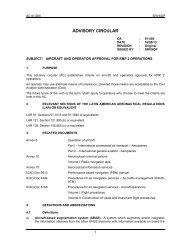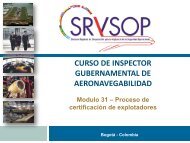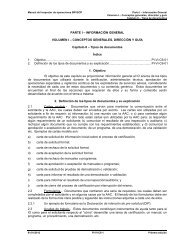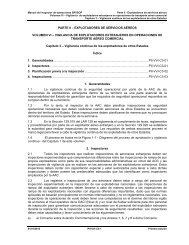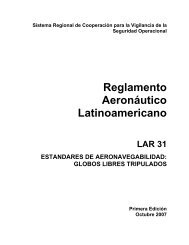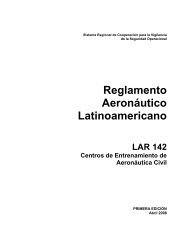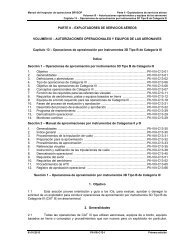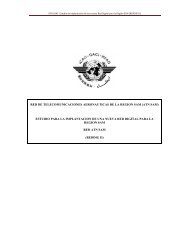CA 91-008 RNP APCH - ICAO
CA 91-008 RNP APCH - ICAO
CA 91-008 RNP APCH - ICAO
You also want an ePaper? Increase the reach of your titles
YUMPU automatically turns print PDFs into web optimized ePapers that Google loves.
SRVSOP AC <strong>91</strong>-<strong>008</strong><br />
ensure that lateral deviation indicator scaling (full-scale deflection) is suitable for the navigation<br />
accuracy associated with the different procedure segments (e.g., ± 1.0 NM for the initial,<br />
intermediate, and missed approach segments, and ± 0.3 NM for the final approach segment).<br />
8) All pilots are expected to maintain procedure centrelines, as depicted by onboard lateral<br />
deviation indicators and/or flight guidance during all the approach procedure unless authorized<br />
to deviate by ATC or in emergency conditions.<br />
9) For normal operations, the cross-track error/deviation (the difference between the <strong>RNP</strong> system<br />
computed path and the aircraft position relative to the path) must be limited to ± ½ of the<br />
navigation accuracy associated with the procedure (e.g., 0.5 NM for the initial, intermediate and<br />
missed approach segments and 0.15 NM for the final approach segment). Brief deviations from<br />
this standard (e.g., overshoots or undershoots) during and immediately after turns, up to a<br />
maximum of one (1) times the navigation accuracy (e.g., 1.0 NM for the initial and intermediate<br />
segments), are allowable.<br />
10) When baro-VNAV is used for vertical path guidance during the final approach segment,<br />
deviations above and below the baro-VNAV path must not respectively exceed + 100/-50 ft.<br />
11) Pilots must execute a missed approach if the lateral or vertical deviations exceed the criteria of<br />
the previous paragraph, unless the pilot has in sight the visual references required to continue<br />
the approach.<br />
12) For aircraft requiring two pilots, the flight crew must verify that each pilot’s altimeter has the<br />
current setting before beginning the final approach of a <strong>RNP</strong> <strong>APCH</strong> approach procedure. The<br />
flight crew must also observe any operational limitations associated with altimeter setting<br />
sources and the latency of checking and setting the altimeters when approaching the FAF.<br />
13) Although the scale should change automatically, the pilots of an aircraft with lateral deviation<br />
indicator (e.g., CDI) must make sure that the scale of the lateral deviation indicator (maximum<br />
deflection) is consistent with the different segments of the procedure (e.g., ± 1.0 NM for the<br />
initial, intermediate, and missed approach segments, and ± 0.3 NM for the final approach<br />
segment).<br />
14) <strong>RNP</strong> <strong>APCH</strong> procedures require flight crew monitoring of lateral and, if installed, vertical track<br />
deviations on the pilot’s primary flight displays (PFD) to ensure the aircraft remains within the<br />
bounds defined by the procedure.<br />
10.7 Contingency procedures<br />
a) The pilots must notify ATC of any loss of the <strong>RNP</strong> <strong>APCH</strong> capability, together with the proposed<br />
course of action.<br />
b) If the pilots cannot meet the requirements of a <strong>RNP</strong> <strong>APCH</strong> procedure, they must notify the air traffic<br />
service (ATS) as soon as possible.<br />
c) The loss of <strong>RNP</strong> <strong>APCH</strong> capability includes any failure or event causing the aircraft to no longer satisfy<br />
the <strong>RNP</strong> <strong>APCH</strong> requirements of the procedure.<br />
d) The operators must develop contingency procedures in order to react safely following the loss of the<br />
<strong>RNP</strong> <strong>APCH</strong> capability during the approach.<br />
e) In the event of communication failure, the flight crew must continue with the <strong>RNP</strong> <strong>APCH</strong> procedure in<br />
accordance with the published lost communication procedure.<br />
f) The operator’s contingency procedures must address at least the following conditions:<br />
1) failure of the <strong>RNP</strong> system components, including those affecting lateral or vertical deviation<br />
performances (e.g., failures of a GPS sensor, FD or AP); and<br />
2) loss of navigation signal-in-space (loss or degradation of the external signal).<br />
g) The pilot must ensure the capability to navigate and land at an alternate aerodrome if loss of <strong>RNP</strong><br />
20



